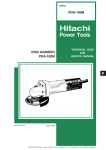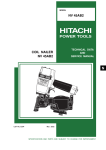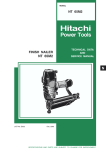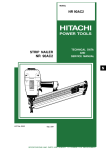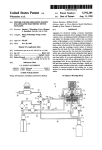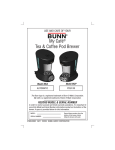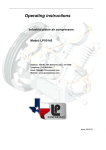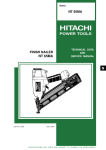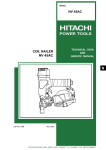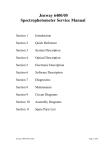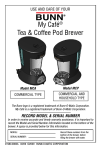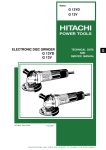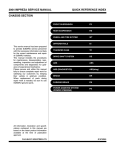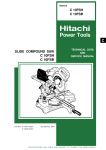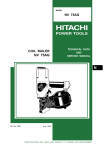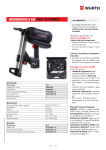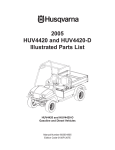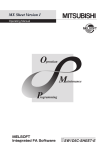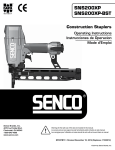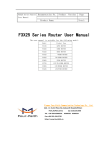Download NR 83AA2 - Cloudfront.net
Transcript
MODEL NR 83AA2 POWER TOOLS STRIP NAILER NR 83AA2 TECHNICAL DATA AND SERVICE MANUAL N LIST No. E001 May 2001 SPECIFICATIONS AND PARTS ARE SUBJECT TO CHANGE FOR IMPROVEMENT REMARK: Throughout this TECHNICAL DATA AND SERVICE MANUAL, a symbol(s) is(are) used in the place of company name(s) and model name(s) of our competitor(s). The symbol(s) utilized here is(are) as follows: Competitors Symbols Utilized Company Name Model Name R SENCO FP650 Y PASLODE P350S CONTENTS Page 1. PRODUCT NAME ........................................................................................................................... 1 2. MARKETING OBJECTIVE ............................................................................................................. 1 3. APPLICATIONS .............................................................................................................................. 1 4. SELLING POINTS .......................................................................................................................... 1 5. SPECIFICATIONS .......................................................................................................................... 2 5-1. Specifications .................................................................................................................................. 2 5-2. Nail Selection .................................................................................................................................. 3 5-3. Nail Driving Force ........................................................................................................................... 4 5-4. Optional Accessories ...................................................................................................................... 5 6. COMPARISONS WITH SIMILAR PRODUCTS .............................................................................. 6 7. PRECAUTIONS IN SALES PROMOTION ..................................................................................... 7 7-1. Instruction Manual .......................................................................................................................... 7 7-2. Warning Label ................................................................................................................................. 7 7-3. Related Laws and Regulations ....................................................................................................... 8 8. MECHANISM AND OPERATION PRINCIPLE ............................................................................... 9 8-1. Mechanism ..................................................................................................................................... 9 8-2. Interchangeability ........................................................................................................................... 11 8-3. Operation Principle ....................................................................................................................... 12 9. TROUBLESHOOTING GUIDE ..................................................................................................... 16 9-1. Troubleshooting and Correction .................................................................................................... 16 9-2. Regrinding the Driver Blade .......................................................................................................... 18 9-3. Possible Causes and Corrections of Air Leakage ......................................................................... 18 10. DISASSEMBLY AND REASSEMBLY ........................................................................................ 20 10-1. General Precautions in Disassembly and Reassembly .............................................................. 20 10-2. Disassembly and Reassembly of the Output Section ................................................................. 21 10-3. Disassembly and Reassembly of the Control Valve Section ...................................................... 25 10-4. Disassembly and Reassembly of the Driving Section and the Magazine Section ...................... 26 11. INSPECTION AND CONFIRMATION AFTER REASSEMBLY .................................................. 28 12. STANDARD REPAIR TIME (UNIT) SCHEDULES ..................................................................... 29 Assembly Diagram for NR 83AA2 1. PRODUCT NAME Hitachi Strip Nailer, Model NR 83AA2 [83 mm (3-1/4")] 2. MARKETING OBJECTIVE The Model NR 83AA2 strip nailer is an upgraded version of the current Model NR 83AA, equipped with the same output section as the Model NR 83AA that is well reputed with its rapid driving and quick response, and the newly designed driving and magazine sections. Primary differences from the Model NR 83AA are described below. (1) Construction of the driving port (nose and piston) is changed to cope with the problem that some of the commercially available nails are apt to clog. (2) The magazine is changed from top loading type to rear loading type so that long strip nails such as SENCO nails can be loaded without folding. In addition, the magazine is lengthened to increase the nail capacity from 82 nails (3.3 mm (0.131 ") dia., HKU) to 86 nails (Paslode F350S: 84 nails). (3) The body handle of the Model NR 83AA is wound with the grip tape, however, dust adheres to the joints of tape and it impairs operability. To cope with this problem, a band-type grip rubber is adopted to the Model NR 83AA2. (4) In the Model NR 83AA2, the magazine section is simplified and no washer is used to reduce parts count for easy maintenance. (5) The claw at the tip of the pushing lever is hardened to increase the wear resistance and the shape of the claw is changed to prevent slipping even when driving nails in a slanting direction. (The change on the shape of claw has also been applied to the current Model NR 83AA from the production of May 2000.) The Model NR 83AA2 is far superior to Paslode F350S and SENCO FP650 in nail driving comfort and ease of operation. Please expand our market share with the new Model NR 83AA2. 3. APPLICATIONS Floor and wall framing Truss build-up, window build-up Subflooring and roof decking Wall sheathing Mobile home and modular housing construction 4. SELLING POINTS Rubber grip Rear loading magazine Rapid driving and quick response --- 1 --- 5. SPECIFICATIONS 5-1. Specifications NR 83AA2 Model Driving system Reciprocating piston type Operating pressure 5 --- 8.5 kgf/cm2 (70 --- 120 psi, 4.9 --- 8.3 bar) (Gauge pressure) Driving speed 3 pcs./sec. Weight 3.8 kg (8.4 lbs.) Dimensions (Length x Height x Width) 460 mm x 360 mm x 108 mm (18-1/8" x 14-3/16" x 4-1/4") Nail feed system Spiral spring Nail capacity 86 to 94 nails Air consumption 2.5 ltr/cycle at 7 kgf/cm2 (0.088 ft3/cycle at 100 psi) (2.5 ltr/cycle at 6.9 bar) Air inlet 3/8 NPT thread Packaging Corrugated cardboard box Package dimensions (Length x Height x Width) 490 mm x 430 mm x 132 mm (19-5/16" x 16-15/16" x 5-3/16") Standard accessories Optional accessories Hex. bar wrench for M5 screw (Code No. 944458) .................................... Hex. bar wrench for M6 screw (Code No. 944459) .................................... Hex. bar wrench for M8 screw (Code No. 872422) .................................... Eye protector (Code No. 875769) .............................................................. Sequential trip mechanism kit (Single-shot) (Code No. 876762) Depth adjustment pushing lever kit (Code No. 883512) Pneumatic tool lubricant (1 oz oil feeder) (Code No. 877153) Pneumatic tool lubricant (4 oz oil feeder) (Code No. 872042) Pneumatic tool lubricant (1 quart can) (Code No. 876212) --- 2 --- 1 1 1 1 5-2. Nail Selection The Model NR 83AA2 utilizes D-head (clipped head) nails collated with paper tape. Applicable nail dimensions are shown below. Please note that screw-type nails cannot be used with the Model NR 83AA2. Ensure that nails are as specified in Fig. 1. The Model NR 83AA2 utilizes D-head (clipped head) nails collated at an angle of 34 degrees which are the same as the nails utilized by a competitor's model Paslode. However, some D-head nails made by other makers are collated at a different angle of 26 degrees. Use of such nails will cause clogging of nails and subsequent damage to the nailer. Also avoid use of misaligned nails or nails collated with a weak paper tape. It is recommended to use genuine HITACHI nails to ensure satisfactory driving quality. Paper tape collated strip nails D-head (clipped head) nails Minimum Maximum 7.1 mm (0.280") 6.8 mm (0.266") 83 mm (3-1/4") 51 mm (2") 3.3 mm (0.131") Max. 4.6 mm (0.181") 2.9 mm (0.113") 34˚ Max. 31.7 mm (1.248") CAUTION: Paper tape Fig. 1 Dimensions of nail --- 3 --- 3.3 mm x 83 mm nails (0.131" x 3-1/4") 5-3. Nail Driving Force Fig. 2 shows by type of wood and nail, the nailer output energy provided by the supply pressure and the nailing energy required for driving the nail flush. Air pressure which exceeds the intersecting point between the nailer output energy and the nailing energy required for driving the nail allows the nail to be fully driven. For example, when driving a nail of 3.3 mm dia. by 83 mm length (0.131" x 3-1/4") into nine sheets of 12 mm plywood (108 mm thick ) with the Model NR 83AA2, a pressure of about 7.0 bar (7.1 kgf/cm2, 102 psi) allows the nailer to drive the nail flush with the wood surface. A pressure beyond this value causes the nail head to be driven below the wood surface. Fig. 2 should be used as reference data because those values vary depending on the type, moisture content, and grain of wood. 1200 1200 R NR 83AA2 Y NR 83AA2 Fig. 2 Required nailing energy and nailer output energy --- 4 --- 5-4. Optional Accessories (1) Sequential trip mechanism kit (Single shot) (Code No. 876762) A sequential trip mechanism kit is provided as an optional accessory for the Model NR 83AA2. By using this optional accessory, a nail is driven by pressing the push lever first against a workpiece and then pulling the trigger (single-shot operation), and no nail is driven when pulling the trigger first and then pressing the push lever against a workpiece. Please recommend the sequential trip mechanism kit to the customers who want to use it. Salespersons must instruct the customers to read the Handling Instructions attached to the sequential trip mechanism kit and also the Handling Instructions of the Model NR 83AA2 thoroughly for correct use. (2) Depth adjustment pushing lever kit (Code No. 883512) The depth adjustment pushing lever kit is available as an optional accessory of the Model NR 83AA2 to adjust the nail driving depth (the adjustment procedure is the same as the current Models NR 90AC and NV 65AH). Salespersons must instruct the customers to read the Handling Instructions attached to the depth adjustment pushing lever kit and also the Handling Instructions of the Model NR 83AA2 thoroughly for correct use. --- 5 --- --- 6 --- 3.7 kg (8.2 lbs.) 465 mm x 330 mm x 114 mm (18-5/16" x 13" x 4-1/2") 2.6 ltr/cycle (0.092 ft3/cycle) 84 nails Top loading 3.8 kg (8.4 lbs.) 425 mm x 360 mm x 108 mm (16-3/4" x 14-3/16" x 4-1/4") 2.5 ltr/cycle (0.088 ft3/cycle) 80 nails Top loading None 3.8 kg (8.4 lbs.) 460 mm x 360 mm x 108 mm (18-1/8" x 14-3/16" x 4-1/4") 2.5 ltr/cycle (0.088 ft3/cycle) 86 nails Rear loading None (Optional accessory: Toolless) Weight 2.9 mm -- 3.8 mm (0.113" -- 0.148") 50 mm -- 90 mm (2" -- 3-1/2") 2.9 mm -- 3.3 mm (0.113" -- 0.131") 50 mm -- 90 mm (2" -- 3-1/2") 2.9 mm -- 3.3 mm (0.113" -- 0.131") 50 mm -- 83 mm (2" -- 3-1/4") 2.9 mm -- 3.3 mm (0.113" -- 0.131") 50 mm -- 83 mm (2" -- 3-1/4") Dia. Length Applicable nails Rubber Racket grip Rubber Grip Leather With wrench (360˚) None None With wrench (Four directions) With wrench Rear loading 67 nails 2.7 ltr/cycle (0.095 ft3/cycle) 381 mm x 362 mm x 106 mm (15" x 14-1/4" x 4-9/64") 3.8 kg (8.4 lbs.) 5 --- 8.5 kgf/cm2 (70 --- 120 psi) R Direction change of exhaust air Driving depth adjustment mechanism Magazine type Nail capacity (0.131” nail) Air consumption at 7 kgf/cm2 (100 psi) Dimensions (L x H x W) With wrench 5.5 --- 8.5 kgf/cm2 (80 --- 120 psi) 5 --- 8.5 kgf/cm2 (70 --- 120 psi) 5 --- 8.5 kgf/cm2 (70 --- 120 psi) Y Operating pressure Model name NR 83AA HITACHI NR 83AA2 Maker 6. COMPARISONS WITH SIMILAR PRODUCTS 7. PRECAUTIONS IN SALES PROMOTION In the interest of promoting the safest and most efficient use of the Model NR 83AA2 Nailer by all of our customers, it is very important that at the time of sale the salesperson carefully ensures that the buyer seriously recognizes the importance of the contents of the Instruction Manual, and fully understands the meaning of the precautions listed on the Warning Label attached to each tool. The Model NR 83AA2 Nailer is designed for continuous nail driving (however, some of the Model NR 83AA2 are designed for single-shot operation only for some destinations). At time of sale, the salesperson must inform the customer that the sequential trip mechanism kit which can change the Model NR 83AA2 to a single-shot nailer is optionally available, and recommend it to the customers who want to use it. Refer to the leaflet attached together with the Instruction Manual for details. 7-1. Instruction Manual Although every effort is made in each step of design, manufacture, and inspection to provide protection against safety hazards, the dangers inherent in the use of any pneumatic tool cannot be completely eliminated. Accordingly, general precautions and suggestions for use of pneumatic tools, and specific precautions and suggestions for the use of the pneumatic nailer are listed in the Instruction Manual to enhance the safe, efficient use of the tool by the customer. Salespersons must be thoroughly familiar with the contents of the Instruction Manual to be able to offer appropriate guidance to the customers during sales promotion. 7-2. Warning Label Each Model NR 83AA2 unit is provided with a Warning Label (illustrated below) which lists basic safety precautions in its use. Carefully ensure that customers fully understand and follow these precautions before using the tool. --- 7 --- The following label is adhered to the Model NR 83AA2 for Europe to prohibit the use of the Model NR 83AA2 standing on a stepladder. Carefully ensure that customers fully understand and follow the precaution before using the tool. 7-3. Related Laws and Regulations As nailers and staplers are designed to instantaneously drive nails and staples, there is an ever-present danger of misfiring and subsequent possible serious injury. Accordingly, close attention in handling is absolutely necessary at all times. Carefully ensure that the customer is fully aware of the precautions listed in the Instruction Manual provided with each unit. While there are no specific safety regulations, there are related items in various general safety regulations with which the salespersons should be familiar in order to properly advise the customer. Please check your national and/or local regulations for applicable items. Some applicable items are outlined below. The U.S.A: OSHA 1926.102 Eye and face protection 1926.302 Power-operated hand tools ANSI SNT-101-1993 Portable, Compressed-Air-Actuated, Fastener Driving Tools-Safety Requirements for --- 8 --- 8. MECHANISM AND OPERATION PRINCIPLE 8-1. Mechanism As illustrated in Fig. 4, the Model NR 83AA2 can be generally divided into four sections: output section, control valve section, driving section and magazine section. The driving section (nose and piston) and the magazine section have been newly designed though its basic construction is the same as that of the Model NR 83AA (valve section is common to the Model NR 83AA). Primary differences from the Model NR 83AA are described below. Whole body ......................... No washer is used for reduction of parts count. (The washer of the exhaust cover mounting screw is integrated with the screw.) Output section ................... The piston (driver blade) has been newly designed to correspond to the nose shape. Owing to the enlargement of the driver blade, the driver blade hole in the piston bumper is also enlarged. The body handle is wound with a band-type grip rubber instead of the racket-grip tape. (Conventional grip tape is supplied as a repair part because the grip rubber cannot be mounted to the body handle by hand.) The other parts are common to the Model NR 93AA. Driving section .................... All the parts have been newly designed. The nail head supporting portion of the nose is widened as shown in Fig. 3 (same construction as Paslode F-350s) to cope with the problem that some of the commercially available nails are apt to clog due to the nail supporting portion is narrow and is apt to wear. Two spring supporters are provided to mount the depth adjustment pushing lever kit (optional accessory). Magazine section ................ All the parts have been newly designed. The magazine section is simpler than the Model NR 83AA for reduction of parts count. The magazine is changed from top loading type to rear loading type (same construction as SENCO FP650). The magazine can be easily mounted by inserting the magazine into the nose and securing the handle arm to the body with a screw. n) o rti g po n rti Nose o pp u s .6 ad 0 Nose Firing gate e lh ai 4 (Nail head supporting portion) (N Firing gate Head of nail NR 83AA Fig. 3 --- 9 --- Head of nail NR 83AA2 The <Bold> numbers in the figure below correspond to the numbers in "8-3. Operation Principle". Exhaust Valve < 2 > Exhaust Vent < 3 > Piston < 4 > Exhaust cover Exhaust piece Accumulator < 1 > Output section Safety valve portion Cylinder < 6 > Trigger valve portion Control valve section Grip rubber Driver Blade < 7 > Return Air Chamger < 8 > Cylinder Spring < 5 > Nail stopper Driving section Piston Bumper < 9 > Nose <10> Magazine Magazine section Firing gate Nail feeder ass'y Pushing lever Fig. 4 Construction --- 10 --- 8-2. Interchangeability The driving section and the magazine section are not interchangeable between the Model NR 83AA2 and the NR 83AA because these sections of the Model NR 83AA2 have been newly designed. The output section and the control valve section are interchangeable except the following parts. Part NR 83AA2 NR 83AA Body Ass'y [26] 5.7 mm dia. hole 5.7 mm dia. hole M8 female screw Piston Bumper (B) [28] 8.3 mm dia. 10 mm dia. Large hole dia. Piston [12] (Driver blade) Nylock Hex. Socket Hd. Bolt M8 x 22 [32] (for mounting the Nose [33]) Hex. Socket Hd. Bolt (W/Flange) M6 x 45 [1] (for mounting the Top Cover [2]) Sectional view Sectional view Nylock Hex. Socket Hd. Bolt M8 x 22 [32] • Short length • No spring washer Spring washer M8 x 25 Nose [33] Hex. Socket Hd. Bolt (W/Flange) M6 x 45 [1] M6 x 45 Spring washer Top Cover [2] Hex. Socket Hd. Bolt (W/SP. Washer) M6 x 25 [3] (for mounting the Exhaust Cover [4]) Hex. Socket Hd. Bolt (W/SP. Washer) M6 x 25 [3] M6 x 25 Spring washer Exhaust Cover [4] --- 11 --- 8-3. Operation Principle The operation of the Model NR 83AA2 is illustrated and described in Fig. 5 through 8. The circled numbers in the descriptions correspond to the item numbers shown in the mechanism illustrated in Fig. 4. In Fig. 6 and Fig. 8, read the descriptions in alphabetical order. Air pressure is applied to the lower surface of the flanges located at the center portion of the Cylinder < 6 >, forcing the cylinder upward. The compressed air is thereby blocked from the upper end of the cylinder, and no pressure is applied to the piston. The Accumlator < 1 > fills with compressed air. The trigger and pushing lever are not operated, and remain closed. The exhaust vents are opened and no air pressure is applied to the valve air passage. Fig. 5 When the compressed air source (air hose) is connected to the nailer --- 12 --- Cylinder ring Compressed air is applied to the upper side of the Exhaust Valve < 2 >, forcing it downward and closing the Exhaust Vent < 3 >. Although air pressure is applied to both the upper and lower sides of the cylinder, the cylinder is forced downward due to the larger effective area of the upper side. Accordingly, the upper portion of the cylinder is opened, and the compressed air forces the piston downward. When the trigger and pushing lever are operated simultaneously, the safety valve and trigger valve are opened. The trigger and pushing lever are operated simultaneously. (NOTE) If either the trigger or pushing lever are operated individually, compressed air will not enter the valve air passage, and the nailer will not function. When the trigger and pushing lever are operated simultaneously, the exhaust vents are closed. As the piston moves downward, the air below the piston is forced into the Return Air Chamber < 8 >. When the piston passes the middle vent, some of the air passes into the return air chamber. This supplies auxiliary air to ensure complete return of the piston. Fig. 6 When the trigger and pushing lever are operated --- 13 --- Air pressure is applied in the shaded areas in the illustration, and each component is held in the position illustrated. If the operator's grip is loosened, air will leak. At there is no o-ring installed here, a very small amount of air will leak from the slight clearance between the components. The lower surface of the Piston < 4 > contacts the Piston Bumper < 9 > and prevents air leakage. If the upper surface of the Piston Bumper < 9 > is damaged, some air will leak. Fig. 7 If the trigger and pushing lever are kept pressed --- 14 --- The air pressure on the upper surface of the Exhaust Valve < 2 > is released, and the exhaust valve is pushed upward by the air pressure within the cylinder. This opens the Exhaust Vent < 3 >, and the air pressure in the cylinder is discharged from the nailer. Air pressure is discharged from the upper end of the cylinder, and the cylinder is pushed upward by the air pressure on the lower surfaces of the flanges and the force of the Cylinder Spring < 5 >. This closes the upper end of the cylinder, and blocks compressed air from entering the cylinder. Valve Exhaust Vent I Valve Exhaust Vent II When the trigger is released, the trigger valve closes and the air pressure within the valve air passage is discharged through Valve Exhaust Vent I . In addition, when the pushing lever is lifted from the wood surface, the safety valve closes, and the air pressure within the valve air passage is discharged through Valve Exhaust Vent II . (The illustration shows both the trigger and pushing lever released.) At the time the piston returns, any remaining air pressure at the lower end of the piston is discharged through the clearance between the Piston Bumper < 9 > and the Driver Blade < 7 >. When the air pressure at the upper side of the piston lowers, the air pressure within the Return Air Chamber < 8 > pushes the piston upward. (NOTE) If the clearance were larger, the piston would not return: if it were smaller, driving force would be decreased. Fig. 8 When the trigger and/or pushing lever are released --- 15 --- 9. TROUBLESHOOTING GUIDE 9-1. Troubleshooting and Correction Problem 1) Nails cannot be driven. ( Possible cause : most-common cause) <Nails> The magazine is not loaded with specified genuine nails. The magazine is loaded with abnormal nails (bent nails, abnormal collation, other). <Magazine> Nail feeder abnormal (burrs, deformed, damaged). Ribbon spring abnormal (fatigued, damaged). Magazine groove too wide or too narrow. Nail rail groove width too wide or too narrow. Inspection method Check if the magazine is normally loaded with specified nails. Check the nail feeding section for abnormal conditions (burrs, fatigued, deformed, damaged). Remedy Use specified nails. Remove the abnormal nails and load the magazine with normal nails. Correct the burred or deformed portion. Replace the defective part. Replace the defective part. Check if they move smoothly after putting nails and check if the nail feeder oeprates smoothly. Replace the defective part. Nail groove in the nose abnormal (burrs). Replace the defective part. Magazine cover abnormal (deformed, damaged). Replace the defective part. Adhesive fragments and wood chips are on the magazine, nail feeder or nail rail. After removing the adhesive fragments and wood chips, apply oil to the nail rail and magazine. <Output section: Piston, driver blade, etc.> Air pressure too low. Piston ring worn. Piston O-ring worn. Keep the nail feeder ass'y pulling backward and perform idle driving. Then check that the driver blade returns to its original position. Piston bumper abnormal. Adjust for 5 to 8.5 kgf/cm2 (4.9 --- 8.3 bar, 7 --- 120 psi). Replace the Piston O-ring. Replace the piston bumper. Cylinder ring abnormal. (dislocated, deformed, damaged). Reassemble or replace. Driver blade abnormal (deformed, burrs, damaged). Touch up or replace. Cylinder's internal surface abnormal (deposites of dirt, worn). <Pushing lever> Pushing lever incorrectly adjusted. Check if nails can be driven at 5 kgf/cm2 (4.9 bar, 70 psi). After removing the dirt, apply oil or replace. Check adjustment. Adjust the protruded amount within 3.5 0.5 mm (0.138" 0.02"). --- 16 --- Problem 2) Nails bent while being driven. ( Possible cause : most-common cause) See item 1). See item 1). Unspecified nails used. See item 1). See item 1). The material being driven into is very hard. Check if the driver blade tip is abnormally worn. Check if a nail is bent even when driven into soft wood. Air pressure too low. Replace the part. Regrind. (See 9-2, "Regrinding the Driver Blade".) Unusable because the tool is not designed for such usage. Adjust for 5 to 8.5 kgf/cm2 (4.9 --- 8.3 bar, 70 --- 120 psi). The material being driven into is very hard. Driver blade worn. Piston O-ring abnormal (worn, damaged). Cylinder's internal surface abnormal (worn, rough). 4) Nails clog the mechanism. Remedy Nails are not fully fed into the injection port. Driver blade worn. 3) The nail is driven into the material but the head is raised above the surface. Inspection method Unspecified nails used. < Improper nail feed > See <Magazine> in item 1). Driver blade worn. < The driver blade has not returned completely. > See <Output section: Piston, driver blade, etc.> in item 1). Drive the nail into soft wood and check if the head is raised or not. Unusable because the tool is not designed for such usage. Check if the driver blade tip is worn. Replace the part. Disassemble the output section and check the Piston O-ring and the internal surface of the cylinder for abnormal condition. Replace the defective part. Check if the nails are specified ones. Use specified nails. Check if they move smoothly after putting nails, and check if the nail feeder operates smoothly. See <Magazine> in item 1). Check if the driver blade tip is worn. Replace the part. Perform idle driving or actually drive with nails, and check if the driver blade has returned completely. See <Output section: Piston, driver blade, etc.> in item 1). --- 17 --- Regrind. (See 9-2, "Regrinding the Driver Blade".) Replace the defective part. Regrind. (See 9-2, "Regrinding the Driver Blade".) 9-2. Regrinding the Driver Blade The tip of the driver blade should be ground as shown in Fig. 9. To grind with a grinder, gradually grind the tip while cooling the ground area with water to prevent it from being excessively heated. Excessive grinding will rapidly reduce the service life of the driver blade. In such a case, replace the driver blade. Driver blade Concave 5˚ Grinding surface Fig. 9 9-3. Possible Causes and Corrections of Air Leakage Air leakage repair location A B G E F C D --- 18 --- Inspection priorities: In the table below, possible causes of air leakage and their repair procedures are marked in accordance with the likelihood of possible failure. (1) First priority items are marked with an asterisk ( ). (2) Second priority items (seal portions) are marked with a double circle ( (3) Remaining items are marked with a single circle ( ). ). (See Parts List and exploded assembly diagram for part name and location.) Cause Air leak part When trigger valve/safety valve are OFF A Exhaust vent B Exhaust cover Cylinder [17] does not return. Swollen Cylinder O-ring [16] (Use of unsuitable oil causes swelling. Advise the customer to use Shell Tonna Oil T32.) Deformed Cylinder [17] or Cylinder Guide [22]. Yielded or broken Cylinder Spring [20]. Defective Head Cap and Gasket Set [10] (worn rubber portion or broken) Broken Gaskets (C) (F) [8] [6] Loose Hex. Socket Hd. Bolt (W/Flange) M6 x 45 [1] Broken Exhaust Cover [4] E Trigger valve F Safety valve G Cap Defective Exhaust Valve [9] (worn, deformed, or broken) Deformed Nose [33] Loose Nylock Hex. Socket Hd. Bolt M8 x 22 [32] Nose D When trigger valve ON/ safety valve OFF Loose Hex. Socket Hd. Bolt (W/SP. Washer) M6 x 25 [3] Broken Gasket (B) [5] Damaged seal surfaces of Body Ass'y [26] and Exhaust Cover [4] C Nose When trigger valve/ safety valve are ON Damaged Cylinder O-ring [18] or O-ring of Cylinder Guide [22] (worn, deformed or broken) Defective Body Ass'y [26] (worn, corroded or deformed) Broken or cracked Piston Bumper (B) [28] Deformed Piston [12] Deformed Nose [33] Defective Plunger O-ring [60] (worn, defomred or broken) Defective outside O-ring [52] of Trigger Valve Bushing [58] Defective Urethane Ball (C) D7.14 [56] (damaged or deformed) Defective ball sheet surface of Trigger Valve Bushing [58] (damaged, deformed or worn) Defective Valve Packing [55] (damaged, deformed or broken) Soiled or damaged valve packing sheet surface of Body Ass'y [26] Incursion of foreign materials Defective Gaskets (C) (F) [8] [6] (damaged or yielded) Deformed or broken Gasket (G) [23] Defective O-ring [13] or Cylinder O-ring [14] of the Cylinder Plate [15] (worn, deformed or broken) Defective Cylinder O-ring [16] (worn, deformed or broken Loose Hex. Socket Hd. Bolt M5 x 18 [40] Broken Gasket (D) [38] Defective seal surface of the Body Ass'y [26] or Cap [39] --- 19 --- Air will leak slightly from the lower portion due to construction. Defective outside O-ring [52] of the Valve Bushing [51] (worn, deformed or broken) Defective plunger O-ring [49] (worn, deformed or broken) Defective Plunger Spring [48] (deformed or broken) Defective safety Valve Bushing [51] (deflected, deformed or broken) 10. DISASSEMBLY AND REASSEMBLY The items particularly necessary for disassembly and reassembly are described below. The [Bold] numbers in the descriptions below correspond to the item numbers in the Parts List and exploded assembly diagram. [CAUTION] Before disassembly or reassembly, be sure to remove all nails and disconnect the air hose from the nailer (with your finger released from the trigger) to exhaust all the compressed air. 10-1. General Precautions in Disassembly and Reassembly Apply grease (Nippeco SEP-3A, Code No. 930035) to the O-rings and O-rings' sliding portions. When installing the O-rings, be careful not to damage the O-rings and prevent dirt entry. Oil required: Hitachi pneumatic tool lubricant 1 oz (30 cc) oil feeder (Code No. 877153) 4 oz (120 cc) oil feeder (Code No. 874042) 1 quart (1 ltr) can (Code No. 876212) If Gasket (B) [5] is damaged, replace it and check that no air is leaking. Be especially careful to prevent the entry of foreign particles into the control valve section. Use the conventional grip tape for repair of the Grip Rubber [37] because the Grip Rubber [37] cannot be mounted without the specifically designed jig. Tightening torque for each part Tightening torque N•m (kgf•cm, ft-lb) Bolt Nylock Hex. Socket Hd. Bolt M8 x 22 ........................... [32] 30.4 2 (310 20, 22.4 1.4) Nylock Bolt (W/Flange) M8 x 16 .................................... [34] 25.5 1 (260 10, 18.8 0.7) Hex. Socket Hd. Bolt (W/Flange) M6 x 45 .................... [1] 12.7 0.8 (130 8, 9.4 0.6) Nylock Bolt (W/Flange) M6 x 12 .................................... [30] 12.7 0.8 (130 8, 9.4 0.6) Hex. Socket Hd. Bolt (W/SP. Washer) M6 x 25 ............. [3] 9.8 0.8 (100 8, 7.2 0.6) Hex. Socket Hd. Bolt (W/Flange) M6 x 12 .................... [74] 9.8 0.8 (100 8, 7.2 0.6) Hex. Socket Hd. Bolt M5 x 18 ....................................... [40] 8.3 0.5 (85 --- 20 --- 5, 6.1 0.4) 10-2. Disassembly and Reassembly of the Output Section (1) Piston [12], Cylinder [17] and related parts Tool required: Hexagon bar wrench (5 mm) (a) Disassembly (See Figs. 10, 11 and 12.) Remove the four Hex. Socket Hd. Bolts (W/SP. Washer) M6 x 25 [3], and take off the Exhaust Cover [4]. The Piston [12] can then be taken out. Next, as illustrated in Fig. 11, screw two of the previously removed Hex. Socket Hd. Bolts (W/SP. Washer) M6 x 25 [3] into the provided holes on the Cylinder Plate [15]. Gripping these two bolts, simultaneously turn and pull upward to remove the Cylinder Plate [15]. When this has been accomplished, the Cylinder [17] and other parts which make up the output section can be removed, as illustrated in Fig. 12. If it is difficult to remove the Cylinder [17], remove the Nose [33] by referring para. 10-2-(3) procedures, and push out the Cylinder [17] from the lower part of the main body. (b) Reassembly Reassembly can be accomplished by following the disassembly procedures in reverse. However, special attention should be given to the following items. Confirm that Gasket (G) [23] is reassembled. Check that the Base Washer [21] is securely and properly mounted to its position in the Body Ass'y [26]. Then mount the other parts. Hex. Socket Hd. Bolt (W/SP. Washer) M6 x 25 [3] Cylinder Plate [15] Exhaust Cover [4] Hex. Socket Hd. Bolt (W/SP. Washer) M6 x 25 [3] Piston [12] Threaded hole for M6 bolts Cylinder [17] Cylinder Plate [15] Gasket (B) [5] Body Ass'y [26] Fig. 10 Fig. 11 --- 21 --- Cylnder Spring [20] Piston [12] Base Washer [21] Cylinder Guide [22] Gasket (G) [23] Cylinder Plate [15] Cylinder [17] Body Ass'y [26] Cylinder Ring [19] Fig. 12 (2) Head Cap and Gasket Set [10], Exhaust Piece [7] and related parts (See Fig. 13.) Tool required: Hex. Socket Hd. Bolt (W/Flange) M6 x 45 [1] Hexagonal bar wrench (5 mm) (a) Disassembly Top Cover [2] Remove the Exhaust Cover [4] as described in section 10-2-(1). Hex. Socket Hd. Bolt (W/SP. Washer) M6 x 25 [3] Loosen the three Hex. Socket Hd. Bolts (W/Flange) M6 x 45 [1] and as illustrated in Fig. 13, remove the Head Cap and Gasket Set [10], Exhaust Valve [9], Exhaust Cover [4] Exhaust Piece [7], Gasket (C) [8] and Gasket (F) [6]. Gasket (B) [5] (b) Reassembly Reassembly can be accomplished by following the Gasket (F) [6] disassembly procedures in reverse. However, special Exhaust Piece [7] attention should be given to the following items. Gasket (C) [8] and Gasket (F) [6] should be replaced Gasket (C) [8] with new genuine Hitachi parts. Exhaust Valve [9] Apply the designated grease to the outer circumference Head Cap and Gasket Set [10] of the Exhaust Valve [9] prior to reassembly. Fig. 13 Disassembly of main body, upper part --- 22 --- (3) Piston Bumper (B) [28], Gasket (A) [29] and related parts (See Figs. 14 and 15.) Tools required Hexagon bar wrench (5 mm, 6 mm) Roll pin puller (3 mm (0.118") dia.) Screwdriver (a) Disassembly Pull out the Roll Pin D3 x 30 [43] and remove the Nylock Bolt (W/Flange) M6 x 12 [30] to remove the Guard [31]. Pull the Nail Feeder Ass'y [69] backward and insert a screwdriver or a rod into the stopper hole for the Nail Feeder Ass'y [69] as shown in Fig. 15. (This is to prevent the Nail Feeder Ass'y [69] from moving forward when removing the Magazine [72].) Remove the Nylock Bolt (W/Flange) M8 x 16 [34] and pull out the entire magazine section backward. Remove the four Nylock Hex. Socket Hd. Bolts M8 x 22 [32]. Then Piston Bumper (B) [28] and Gasket (A) [29] can be removed together with the Nose [33]. (b) Reassembly Disassembly procedures should be followed in the reverse order. Note the following points. Plunger (B) [54] is apt to come off during disassembly. Be sure to check that Plunger (B) [54] is securely mounted during reassembly. Pressing the Magazine [72] against the Nose [33], secure them with the Nylock Bolt (W/Flange) M8 x 16 [34] with a minimum clearance between the Magazine [72] and the Nose [33]. Mount the Roll Pin D3 x 30 [43] without fail. Roll Pin D3 x 30 [43] Plunger (B) [54] Body Ass'y [26] Nylock Bolt (W/Flange) M8 x 16 [34] Piston Bumper (B) [28] Gasket (A) [29] Nylock Bolt (W/Flange) M6 x 12 [30] Guard [31] Nylock Hex. Socket Hd. Bolt M8 x 22 [32] Nose [33] Magazine [72] Fig. 14 --- 23 --- Nail Feeder Ass'y [69] Insert a bar such as a screwdriver into this hole. Fig. 15 --- 24 --- 10-3. Disassembly and Reassembly of the Control Valve Section Tools required: Roll pin puller (3 mm (0.118") dia.) Minus-hd. screwdriver (a) Disassembly (See Fig. 16.) Remove the Magazine [72] as described in section 10-2-(3). Remove the Pushing Lever [46] as described in section 10-2-(3). With the roll pin puller (3 mm (0.118") dia.), take out the Roll Pin D3 x 30 [43], and remove the Trigger [53], Trigger Plunger [59] and Plunger (B) [54]. Insert the minus-hd. screwdriver into the groove of the Trigger Valve Bushing [58], and loosen it by turning it to the left, being careful not to damage the groove. After removing the Trigger Valve Bushing [58], pull down strongly on the Valve Bushing [51] to remove the Valve Bushing [51], Plunger (A) [50] and the Plunger Spring [48]. Valve Plate [57] Plunger Spring [48] Trigger Valve Bushing [58] Plunger (A) [50] Trigger Plunger [59] Valve Bushing [51] Roll Pin D3 x 30 [43] Trigger [53] Fig. 17 Fig. 16 Disassembly of valve Plunger (B) [54] (b) Reassembly Reassembly can be accomplished by following the disassembly procedures in reverse. However, special attention should be given to the following items. Plunger (A) [50] Plunger (B) [54] Be very careful in handling the Plunger Spring [48], as it can become twisted very easily. To prevent the two O-rings on the outside of the Valve Bushing [51] from being damaged when inserted into Safety Bolt [44] the body, carefully apply grease to the body hole and Nut M5 [47] the outer circumference of the O-rings prior to assembly. Nose [33] (c) Adjustment of the Pushing Lever [46] (See Fig. 17.) Pushing Lever [46] The Pushing Lever [46] can be adjusted by loosening the Nut M5 [47] and turning the Safety Bolt [44]. Perform adjustment to a point where the resistance of Plunger (B) [54] pushing up Plunger (A) [50] is felt when the pushing lever is raised. At this point, the lower end of the Nose [33] should be separated from the lower end of the pushing lever by 3.5 mm 0.5 mm (.138" Fig. 17 Pushing lever adjustment .020"). --- 25 --- 10-4. Disassembly and Reassembly of the Driving Section and the Magazine Section (1) Nose [33], Pushing Lever [46] and the related parts (See Fig. 18.) Tool required Hexagon bar wrench (5 mm) (a) Disassembly Perform disassembly according to 10-2-(3) to remove the Nose [33], Pushing Lever [46], and the other parts. Remove the Nose Rubber [61] from the Nose [33] by stretching the Nose Rubber [61] with a thin rod. (b) Reassembly Disassembly procedures should be followed in the reverse order. Note the following points. Be careful of the mounting direction of the Nose Rubber [61]. Mount the Nose Rubber [61] aligning with the shape of the Nose [33]. Hook the Spring [45] in the 3 mm dia. hole of the Nose [33] aligning with the shape of the Pushing Lever [46]. (The Nose [33] has two 3 mm dia. holes, one is for hooking the Spring [45] and the other is for the depth adjustment pushing lever kit (optional accessory).) Do not insert a roll pin into the other 3 mm dia. hole. This hole is for the depth adjustment pushing lever kit (optional accessory). Nose Rubber [61] Nylock Hex. Socket Hd. Bolt M8 x 22 [32] Safety Bolt [44] Spring [45] Nose [33] Pushing Lever [46] Nut M5 [47] 3 mm dia. hole Fig. 18 --- 26 --- (2) Magazine [72], Nail Feeder Ass'y [69] and the related parts (See Fig. 19.) Tool required Hexagon bar wrench (5 mm ) (a) Disassembly Perform disassembly according to 10-2-(3) to remove the entire magazine section. Remove a screwdriver or a rod from the the stopper hole for the Nail Feeder Ass'y [69]. Then the Nail Feeder Ass'y [69], Ribbon Spring [70] and Needle Roller D4 x 20 [71] can be removed from the front of the Magazine [72]. Remove the three Hex. Socket Hd. Bolts (W/Flange) M6 x 12 [74]. Then Handle Arm [36], Nail Stopper [75] and Magazine Cover [64] can be removed together with the other parts. The Nail Rail [62] that is press-fitted into the Magazine [72] has a protrusion at the rear end to prevent coming off. Tap at the front of the Magazine [72] using a hammer and a bar being careful not to scratch the parts. (b) Reassembly Disassembly procedures should be followed in the reverse order. Note the following points. Insert the Nail Rail [62] from the rear of the Magazine [72] and press-fit the Nail Rail [62] into the Magazine [72] by tapping with a wooden hammer so that the protrusion of the Nail Rail [62] becomes flush with the rear end of the Magazine [72]. Hook the hook of the Ribbon Spring [70] on the Magazine [72] then mount the Nail Feeder Ass'y [69] to the Magazine [72]. Slide the Nail Feeder Ass'y [69] backward and insert a screwdriver or a rod into the stopper hole for the Nail Feeder Ass'y [69] as shown in Fig. 15. Press the mounting surface of the Nail Stopper [75] against the Magazine [72] and slide it backward until the "A" portion fits into the concave portion of the Magazine Cover [64] then secure them with the bolt. At this time, mount the Sleeve [63] without fail. Concave portion Nylon Nut M6 [35] Sleeve [63] Magazine Cover [64] Convex portion Rear Nail Rail [62] Hooking portion A Nail Stopper [75] [74] Hex. Socket Hd. Bolt (W/Flange) M6 x 12 Ribbon Spring [70] Hook Nail Feeder Ass'y [69] Magazine [72] Front Needle Roller D4 x 20 [71] Fig. 19 --- 27 --- (3) Nail Feeders (A) [65], (B) [67] and the related parts (See Fig. 20.) Tool required Roll pin puller (4 mm (0.157") dia.) (a) Disassembly Fix the Nail Feeder Ass'y [69] using a V-block and pull out the Roll Pin D4 x 40 [66] from the top using a roll pin puller (4 mm (0.157") dia.). Then Nail Feeder (A) [65], Nail Feeder (B) [67] and Feeder Spring [68] can be removed. (b) Reassembly Disassembly procedures should be followed in the reverse order. Note the following points. Insert the Roll Pin D4 x 40 [66] into Nail Feeder (B) [67]. Insert the Feeder Spring [68] into the hole of the Nail Feeder (B) [67] and compress the Feeder Spring [68] until it is engaged with the protrusion of Nail Feeder (A) [65]. Protrusion Roll Pin D4 x 40 [66] Nail Feeder (A) [65] [69] Nail Feeder Ass'y Hole [67] [68] Nail Feeder (B) Feeder Spring Fig. 20 11. INSPECTION AND CONFIRMATION AFTER REASSEMBLY Check that Plunger (B) [54] and Trigger Plunger [59] move smoothly. Check that there is no air leakage from each part. While driving nails with an air pressure of 4.5 kgf/cm2 (63 psi), check that there is no idle driving and bending of nails. Recheck the tightening torque of each screw. Check that Pushing Lever [46] slides smoothly. Check that the machine will not operate only by actuating Trigger [53]. Also check that the machine will not operate only by depressing Pushing Lever [46]. --- 28 --- 12. STANDARD REPAIR TIME (UNIT) SCHEDULES MODEL Variable Fixed 10 20 30 Top Cover Exhaust Cover Gasket x 3 Exhaust Piece Exhaust Valve Head Cap and Gasket Set Tail Cover Magazine Magazine Cover Ribbon Spring Nail Feeder Ass'y Pushing Lever Spring Cylinder Plate Cylinder Cylinder Spring O-ring x 7 Piston Bumper (B) 40 50 60 min. Work Flow NR 83AA2 General Assembly Plunger Spring Plunger (A) Valve Bushing Trigger Plunger (B) O-ring x 3 Valve Packing O-ring x 2 Trigger Valve Bushing Trigger Plunger Piston O-ring (1AP-48) Adjustment (Cylinder, Body) --- 29 --- Adjustment (Valve, Return Valve) Body Ass'y LIST NO. E001 PNEUMATIC TOOL PARTS LIST STRIP NAILER Model NR 83AA2 2001• 3 • 15 (E1) 501 502 503 504 506 507 505 1 2 76 3 34 20 35 4 5 77 78 79 80 81 41 40 36 39 38 21 13 55 56 6 7 8 52 22 57 37 48 13 23 9 12 24 42 26 43 52 44 53 45 54 30 15 31 61 75 74 74 32 66 19 73 70 33 18 35 62 16 17 64 47 28 14 43 63 46 27 29 60 51 25 13 59 50 10 11 58 49 71 65 69 67 68 72 PARTS ITEM NO. * CODE NO. NR 83AA2 NO. DESCRIPTION USED HEX. SOCKET HD. BOLT (W/FLANGE) M6X45 3 1 883-509 2 877-330 TOP COVER 1 3 883-507 HEX. SOCKET HD. BOLT (W/SP.WASHER) M6X25 4 4 877-324 EXHAUST COVER 1 5 877-325 GASKET (B) 1 6 877-329 GASKET (F) 1 7 877-328 EXHAUST PIECE 1 8 877-854 GASKET (C) 1 9 878-417 EXHAUST VALVE 1 10 877-307 HEAD CAP AND GASKET SET 1 11 877-368 O-RING (1AP-48) 1 12 883-510 PISTON 1 13 877-316 O-RING (S-90) 3 14 877-312 CYLINDER O-RING (I.D 63.1) 1 15 877-318 CYLINDER PLATE 1 16 877-313 CYLINDER O-RING (I.D 79.3) 1 17 877-810 CYLINDER 1 18 877-314 CYLINDER O-RING (I.D 69.3) 1 19 877-317 CYLINDER RING 1 20 877-321 CYLINDER SPRING 1 21 877-322 BASE WASHER 1 22 877-310 CYLINDER GUIDE 1 23 877-327 GASKET (G) 1 24 878-184 WARNING LABEL 1 25 878-183 WARNING LABEL 1 FOR FRA 26 883-506 BODY ASS’Y 1 INCLUD.37 27 877-315 CYLINDER O-RING (I.D 63.9) 1 28 883-511 PISTON BUMPER (B) 1 29 877-334 GASKET (A) 1 30 882-974 NYLOCK BOLT (W/FLANGE) M6X12 1 31 883-493 GUARD 1 32 883-492 NYLOCK HEX. SOCKET HD. BOLT M8X22 4 33 883-490 NOSE 1 34 883-505 NYLOCK BOLT (W/FLANGE) M8X16 1 35 963-837 NYLON NUT M6 3 36 883-504 HANDLE ARM 1 37 38 877-331 GRIP RUBBER 1 GASKET (D) 1 39 878-311 CAP 1 40 949-658 HEX. SOCKET HD. BOLT M5X18 (10 PCS.) 3 41 872-035 42 DUST CAP 1 NAME PLATE 1 43 949-866 ROLL PIN D3X30 (10 PCS.) 2 44 875-650 SAFETY BOLT 1 * 45 877-365 SPRING 1 * 45 878-423 SPRING 1 * * REMARKS 46 883-494 PUSHING LEVER 1 47 949-555 NUT M5 (10 PCS.) 1 48 875-643 PLUNGER SPRING 1 49 874-436 O-RING (P-4) 1 50 877-338 PLUNGER (A) 1 --- 2 --- * ALTERNATIVE PARTS (SUPPLIED WITH ITEM NO.602,603) FOR FRA FOR TPE,FRA,USA,CAN FOR TPE,FRA,USA,CAN 3 -- 01 PARTS * * NR 83AA2 ITEM NO. CODE NO. 51 877-337 VALVE BUSHING 52 875-638 O-RING (S-12) 53 876-203 TRIGGER 1 54 877-339 PLUNGER (B) 1 NO. REMARKS USED 1 FOR TPE,FRA,USA,CAN DESCRIPTION 3 55 878-734 VALVE PACKING 1 56 875-645 URETHANE BALL (C) D7.14 1 57 875-644 VALVE PLATE 1 58 877-335 TRIGGER VALVE BUSHING 1 59 878-121 TRIGGER PLUNGER 1 60 874-820 PLUNGER O-RING 1 61 883-491 NOSE RUBBER 1 62 883-496 NAIL RAIL 1 63 883-499 SLEEVE 1 64 883-497 MAGAZINE COVER 1 65 883-502 NAIL FEEDER (A) 1 66 949-688 ROLL PIN D4X40 (10 PCS.) 1 67 883-501 NAIL FEEDER (B) 1 68 883-441 FEEDER SPRING 1 69 883-500 NAIL FEEDER ASS’Y 1 70 883-503 RIBBON SPRING 1 71 943-364 NEEDLE ROLLER D4X20 1 72 883-495 MAGAZINE 1 LABEL 1 73 FOR TPE,FRA,USA,CAN INCLUD.65-68 74 984-443 HEX. SOCKET HD. BOLT (W/FLANGE) M6X12 3 75 883-498 NAIL STOPPER 1 * 76 882-408 PLUNGER SPRING (S) 1 FOR SEQUENTIAL TRIP MECHANISM TYPE * 77 874-436 O-RING (P-4) 1 FOR SEQUENTIAL TRIP MECHANISM TYPE * 78 882-409 PLUNGER (S) 1 FOR SEQUENTIAL TRIP MECHANISM TYPE * 79 882-411 BUSHING (S) 1 FOR SEQUENTIAL TRIP MECHANISM TYPE * 80 882-412 ROD SPRING (S) 1 FOR SEQUENTIAL TRIP MECHANISM TYPE * 81 882-410 ROD (S) 1 FOR SEQUENTIAL TRIP MECHANISM TYPE 3 -- 01 * ALTERNATIVE PARTS --- 3 --- NR 83AA2 STANDARD ACCESSORIES ITEM NO. CODE NO. 501 872-422 HEX. BAR WRENCH 6MM 1 502 944-459 HEX. BAR WRENCH 5MM 1 503 944-458 HEX. BAR WRENCH 4MM 1 NO. USED DESCRIPTION REMARKS 504 875-769 EYE PROTECTOR 1 * 505 877-153 PNEUMATIC TOOL LUBRICANT (30CC) 1 FOR FRA * 506 882-413 CAUTION TAG 1 FOR USA,CAN * 507 882-414 LEAFLET 1 FOR USA,CAN OPTIONAL ACCESSORIES ITEM NO. CODE NO. 601 876-762 SEQUENTIAL TRIP MECHANISM KIT 1 602 881-768 GRIP TAPE (A) 1 603 880-407 TAPE 1 --- 4 --- NO. USED DESCRIPTION * ALTERNATIVE PARTS REMARKS Printed in Japan (010315N) 3 -- 01





































